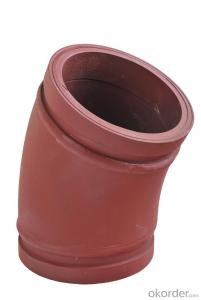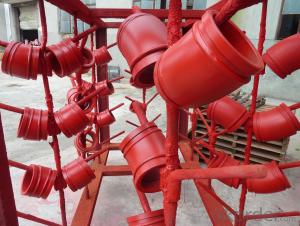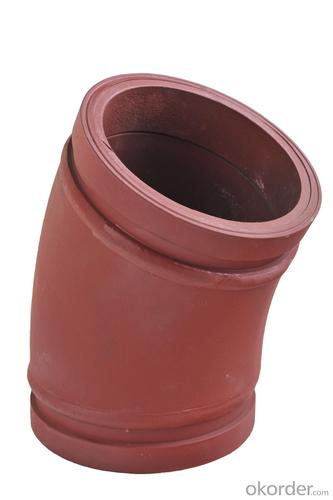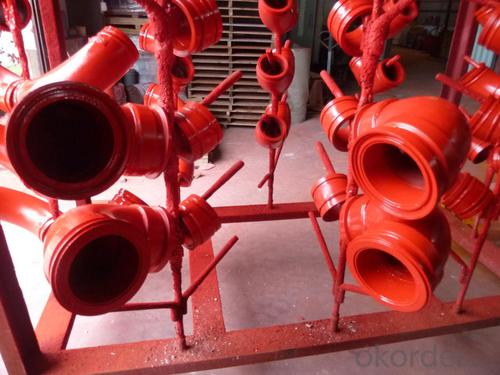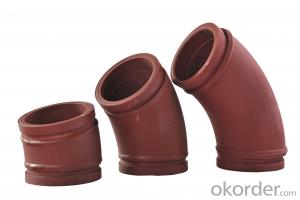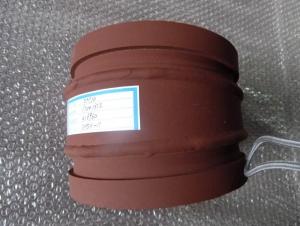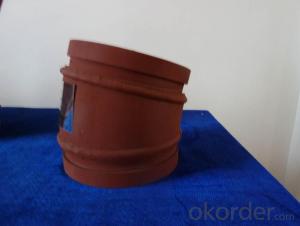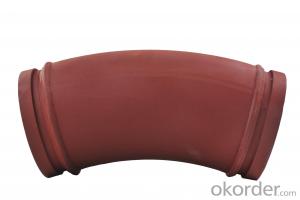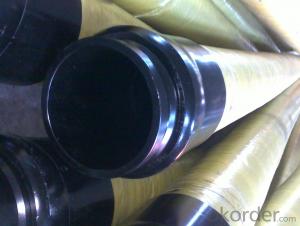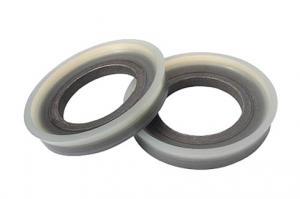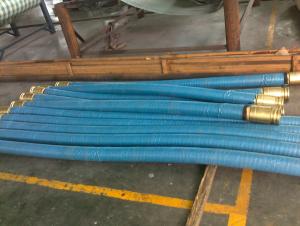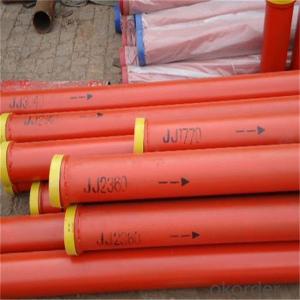Twin Wall Elbow for Concrete Pump R275 36DGR
- Loading Port:
- Tianjin
- Payment Terms:
- TT OR LC
- Min Order Qty:
- 10 pc
- Supply Capability:
- 3000 pc/month
OKorder Service Pledge
OKorder Financial Service
You Might Also Like
Twin Wall Elbow (Twin Wall Flange)
(1) Material: Q235 (outside) + GCr15(inside)
(2) Thickness: 3mm (outside) + 9mm (inside)
(3) Technology: Quenching under high temperature
(4) Characteristics: the inner rigidity to 63 HRC; the outside has so high toughness to keep the inner.
(5) Matched with: Twin wall flange, Alloy (GCr15) + 20#
(6) Working Pressure:170bar
(7) Service life: above 60,000 cubic meters.
(8) Package: PP woven bag and plastic cap
Twin wall elbow is created with research of us and need of the market. Its service life and working pressure are better than the casting. Besides, We can supply 90D, 45D, 30D, 25D, 20D, 15D, 10D. And it can be used for PM, JUNJIN, Schwing, Cifa, Sany, ect.
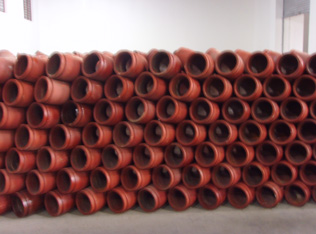
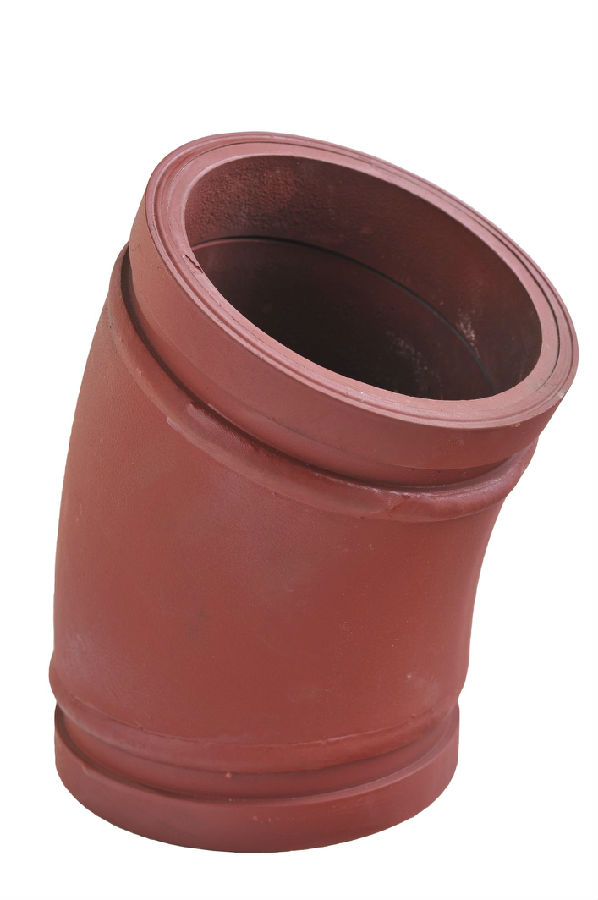
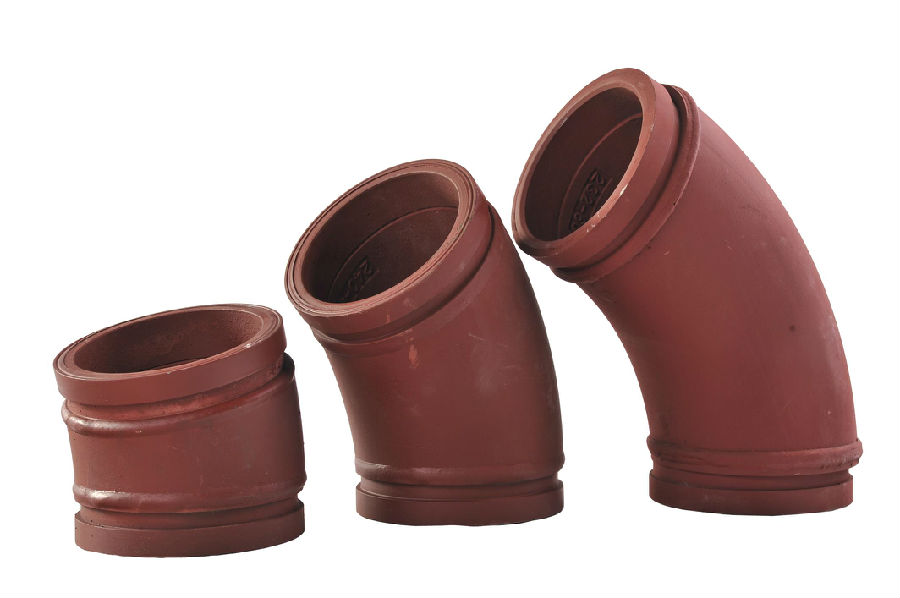
- Q: What are the different types of concrete pump hopper pins?
- There are several types of concrete pump hopper pins, including snap pins, lynch pins, and clevis pins. These pins are used to secure the hopper to the pump and ensure it stays in place during operation.
- Q: How often should a concrete pump cleaning ball be used?
- A concrete pump cleaning ball should be used after every pumping job or at least once a day to ensure the cleanliness and proper functioning of the pump. The cleaning ball helps remove any build-up or debris that may have accumulated inside the pump and its pipes during the pumping process. Regular use of a cleaning ball helps prevent clogs and blockages, ensuring a smooth and efficient pumping operation.
- Q: How does a concrete pump S valve function?
- A concrete pump S valve functions by controlling the flow of concrete from the hopper to the delivery pipeline. It consists of two flat plates attached to a shaft that can rotate. When the S valve is in the closed position, the plates are pressed together to prevent the concrete from flowing through. As the shaft rotates, the plates separate, allowing the concrete to pass through and be pumped to the desired location. This mechanism ensures efficient and precise control of concrete flow during pumping operations.
- Q: Are there any environmental considerations in the production of concrete pump spare parts?
- Concrete pump spare parts have several environmental considerations. Firstly, the production process involves the use of various materials and chemicals that can harm the environment. For instance, steel components require the extraction of iron ore and emit greenhouse gases during smelting. Similarly, rubber parts use petroleum-based materials, which contribute to carbon emissions and pollution. Additionally, the disposal of these spare parts after their useful life can create environmental challenges. If not managed properly, they can end up in landfills, leading to waste accumulation and potential soil and water contamination. Hence, it is crucial to consider the recyclability and reusability of these parts during their design and production. To address these concerns, manufacturers can adopt sustainable practices. This includes incorporating recycled materials like steel or rubber into the manufacturing process. Moreover, efficient production techniques can reduce waste generation and energy consumption. Establishing proper waste management and recycling programs is also vital for responsible disposal of these spare parts. Overall, by considering the environmental impacts associated with the production and disposal of concrete pump spare parts, manufacturers can contribute to a more sustainable and eco-friendly industry.
- Q: Are there any specific maintenance practices for concrete pump spare parts?
- Yes, there are specific maintenance practices that should be followed for concrete pump spare parts. Firstly, it is important to regularly inspect the spare parts for any signs of wear or damage. This includes checking for cracks, leaks, or any other visible defects. If any issues are detected, the spare parts should be replaced or repaired immediately to prevent further damage. Secondly, it is crucial to clean the spare parts on a regular basis. Concrete pump spare parts often come into contact with cement, water, and other substances that can cause build-up and affect their performance. Regular cleaning will help remove any debris or residue, ensuring that the spare parts function optimally. Additionally, lubrication is an essential maintenance practice for concrete pump spare parts. Lubricating moving components such as bearings, seals, and pistons will help reduce friction and wear, extending the lifespan of the spare parts. It is important to use the correct lubricants specified by the manufacturer and follow their guidelines for application. Furthermore, proper storage of spare parts is also important for their maintenance. They should be stored in a clean and dry environment, away from any chemicals or other substances that could damage them. Spare parts should also be stored in a way that protects them from physical damage, such as being dropped or bumped. Lastly, it is recommended to follow the manufacturer's guidelines and recommendations for maintenance and replacement intervals. Regular servicing and inspections by qualified technicians can help identify any potential issues early on and prevent major breakdowns or failures. In conclusion, following specific maintenance practices such as regular inspection, cleaning, lubrication, proper storage, and adherence to manufacturer's guidelines are crucial for ensuring the optimal performance and longevity of concrete pump spare parts.
- Q: How can I extend the lifespan of my concrete pump spare parts?
- To extend the lifespan of your concrete pump spare parts, there are several key steps you can take: 1. Regular maintenance: Implement a comprehensive maintenance schedule for your concrete pump, including the spare parts. This should include regular inspections, cleaning, and lubrication of the parts. By identifying and addressing any issues early on, you can prevent further damage and extend the lifespan of the parts. 2. Use high-quality spare parts: Invest in high-quality spare parts from reputable manufacturers. Cheaper alternatives may save you money initially, but they tend to have shorter lifespans and may require frequent replacements. Opting for quality parts will ensure durability and longevity. 3. Proper storage: Store your spare parts in a clean, dry, and well-organized environment. Exposure to moisture, extreme temperatures, and dirt can deteriorate the parts over time. Consider using protective covers or cases to shield the parts from dust and other contaminants. 4. Train operators: Proper operation of the concrete pump is crucial to preventing unnecessary wear and tear on the spare parts. Ensure that your operators are well-trained and follow the manufacturer's guidelines for usage and maintenance. Discourage any misuse or improper handling of the equipment, as this can lead to premature wear of the spare parts. 5. Regular cleaning: Keep your concrete pump clean by regularly removing any concrete buildup. The accumulation of hardened concrete can cause additional strain on the spare parts and lead to premature failure. Use appropriate cleaning methods and tools to ensure thorough removal without causing damage to the parts. 6. Timely repairs: Address any issues or damage to the spare parts as soon as they are identified. Ignoring or delaying repairs can worsen the problem and potentially cause damage to other components. Regularly inspect the spare parts for signs of wear, such as cracks, leaks, or excessive vibration, and promptly address any concerns. 7. Monitor usage and performance: Keep track of the usage and performance of your concrete pump and spare parts. Regularly monitor the wear and tear of the parts and the overall performance of the pump. Analyze any patterns or trends that may indicate potential problems and take corrective actions to prevent further damage. By following these steps, you can significantly extend the lifespan of your concrete pump spare parts, ensuring optimal performance and reducing the need for frequent replacements.
- Q: How often should hydraulic filters be replaced in a concrete pump?
- Hydraulic filters in a concrete pump should be replaced regularly, typically every 500 to 1,000 operating hours or as recommended by the manufacturer. Regular replacement ensures optimal performance and helps prevent contamination and damage to the hydraulic system.
- Q: How do I maintain the performance of concrete pump spare parts in extreme weather conditions?
- To ensure the efficiency and longevity of your equipment, it is crucial to maintain the performance of concrete pump spare parts in extreme weather conditions. Consider the following tips: 1. Conduct regular inspections to detect signs of wear and tear early on. Extreme weather can accelerate part deterioration, so staying vigilant is important. 2. Keep spare parts clean to prevent clogging or damage caused by dirt, debris, or contaminants that may accumulate in extreme weather conditions. 3. Use appropriate lubrication for smooth functioning. Opt for lubricants designed for extreme weather, with high viscosity and resistance to temperature fluctuations. 4. Protect spare parts from direct exposure to extreme heat or freezing temperatures by using covers or enclosures. 5. Store spare parts in a dry, temperature-controlled environment when not in use. Extreme weather can cause expansion or contraction, potentially leading to damage. Controlled storage helps maintain integrity and performance. 6. Monitor and replace worn-out parts in a timely manner to maintain performance. Extreme weather conditions can accelerate wear and tear, so proactive replacement is crucial. 7. Consult the manufacturer for specific requirements on maintaining spare parts in extreme weather. They can offer expert advice and guidance for optimal performance. By following these tips, you can effectively preserve the performance of concrete pump spare parts in extreme weather conditions, ensuring smooth and efficient equipment operation.
- Q: Are there any specific safety precautions while replacing concrete pump spare parts?
- There exists a variety of safety precautions that must be followed when replacing concrete pump spare parts. 1. Personal Protective Equipment (PPE) is of utmost importance and should be worn to safeguard against potential hazards. This includes safety goggles, gloves, a helmet, and steel-toed boots. 2. It is essential to adhere to proper lockout/tagout procedures prior to replacing any spare parts. This entails disconnecting and securing the power source to prevent accidental startup of the pump. 3. Before commencing the replacement process, inspect all tools and equipment for any indications of damage or defects. It is crucial to refrain from using faulty equipment, as it can pose significant safety risks. 4. When handling heavy spare parts, it is imperative to employ appropriate lifting techniques to prevent strain or injury. Ensure that proper assistance and equipment, such as cranes or forklifts, are available if necessary. 5. Maintain a clean and well-organized work area to prevent trips, slips, and falls. Remove any obstacles or debris that may jeopardize safety during the replacement process. 6. Only trained and authorized personnel should be involved in the replacement of concrete pump spare parts. They must possess a thorough understanding of the equipment and procedures to minimize the likelihood of accidents. 7. Always consult the manufacturer's guidelines and instructions when replacing spare parts. This will ensure that the process is executed safely and accurately. 8. It is vital to have a plan in place for potential emergencies, including fires or injuries. Make certain that fire extinguishers and first aid kits are easily accessible, and that all workers are familiar with their locations and usage. By adhering to these safety precautions, the risk of accidents, injuries, and damage can be significantly reduced when replacing concrete pump spare parts.
- Q: How long do concrete pump spare parts typically last?
- There are several factors that can affect the lifespan of concrete pump spare parts. Generally, high-quality parts can last between 1,000 and 2,500 working hours. However, this estimate can be influenced by factors such as the type and brand of the spare parts, how often they are used, the quality of maintenance they receive, and the working conditions in which the concrete pump operates. Some spare parts for concrete pumps may have a shorter lifespan due to the wear and tear they experience during operation. For example, wear parts like rubber seals, pistons, and wear plates are more prone to damage and may need to be replaced more frequently. On the other hand, structural components like pipes, hoses, and hydraulic cylinders tend to last longer. Extending the lifespan of concrete pump spare parts relies on proper maintenance and regular inspections. Adequate lubrication, cleaning, and timely replacement of worn-out parts can significantly increase their durability. Additionally, the expertise and skill of the operator also play a role in the lifespan of the spare parts, as improper use or mishandling can lead to premature failure. While it is possible to estimate the average lifespan of concrete pump spare parts, it is important to consider the specific circumstances and conditions in which the concrete pump operates to determine their actual longevity. Regular maintenance, the use of high-quality parts, and proper usage will ultimately help maximize the lifespan of concrete pump spare parts.
Send your message to us
Twin Wall Elbow for Concrete Pump R275 36DGR
- Loading Port:
- Tianjin
- Payment Terms:
- TT OR LC
- Min Order Qty:
- 10 pc
- Supply Capability:
- 3000 pc/month
OKorder Service Pledge
OKorder Financial Service
Similar products
Hot products
Hot Searches
Related keywords
